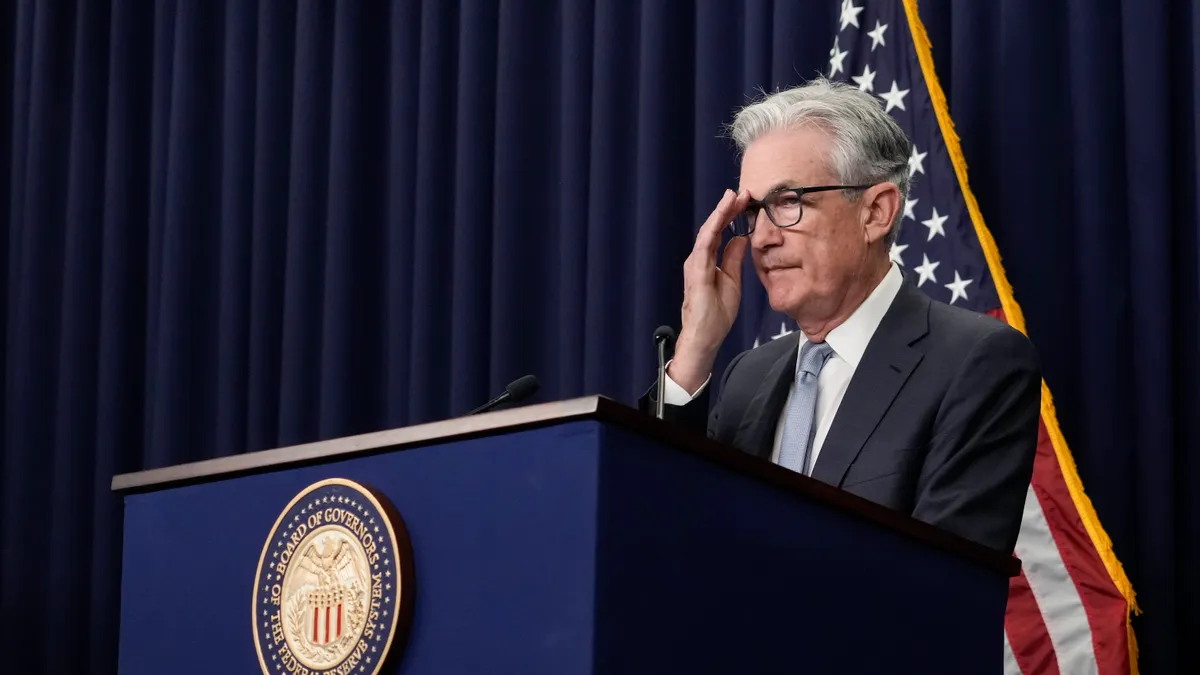Dive Brief:
- The Federal Reserve redoubled its fight against the highest inflation in nearly four decades, raising the benchmark interest rate Wednesday by 75 basis points for the third straight meeting and pushing up estimates for increases in borrowing costs through next year.
- Policymakers lifted the federal funds rate to a range between 3% and 3.25%. The median projection showed that they expect to lift the rate to around 4.4% by the end of 2022 — a full percentage point above their June estimate — and to 4.6% by the end of next year.
- “The FOMC [Federal Open Market Committee] is strongly resolved to bring inflation down to 2%,” Fed Chair Jerome Powell said during a press briefing after the unanimous decision by policymakers. “Restoring price stability will likely require maintaining a restrictive policy stance for some time,” he said, adding that “the historical record cautions strongly against prematurely loosening policy.”
Dive Insight:
Many CFOs this year have had to revise their calculus for borrowing, investment, capital structure and other balance sheet plans as the Fed withdrew record stimulus to slow the economy and curb inflation.
The most aggressive Fed tightening since the 1980s has pushed up borrowing costs and prompted companies to mark down profit forecasts for coming quarters.
The yield on the 10-year Treasury note, a benchmark for the cost of borrowing, jumped Tuesday to 3.57%, the highest close in more than 11 years.
“The recent interest rate surge is due to the market’s recognition of two critical factors — that inflation is indeed not transitory and that, to tame it, the Federal Reserve will need to be resolute, even at the risk of possible recession,” Fannie Mae Chief Economist Doug Duncan said Wednesday.
Policymakers revised upward their forecast for price gains. The median projection showed they expect their preferred measure of inflation — the core personal consumption expenditures (PCE) price index — to rise 4.5% by the end of this year and 3.1% by December 2023. Core PCE was 4.6% in July, well above the Fed’s 2% inflation target.
“We have got to get inflation behind us,” Powell said. “I wish there were a painless way to do that — there isn't.”
U.S workers will bear some of the pain in the form of higher unemployment, the central bank indicated.
Fed officials raised their expectation for unemployment this December to 3.8% from a 3.7% forecast in June.
By December 2023, the jobless rate will likely rise to 4.4%, according to policymakers’ median projection. In June they forecast 4.1% unemployment for the end of next year. Unemployment rose last month to 3.7%.
Similarly, policymakers trimmed their expectations for economic growth. They forecast a gross domestic product gain of just 0.2% this year, down from a June estimate of 1.7%. For next year, they predict 1.2% growth compared with a 1.7% forecast in June.
Referring to the withdrawal of stimulus, Powell said, “no one knows whether this process will lead to a recession or if so, how significant that recession would be.
“That's going to depend on how quickly wage and price inflation pressures come down, whether [inflation] expectations remain anchored and whether” the supply of labor increases, he said.
After shrinking during the first half of 2022, the economy will probably resume its expansion during the second half and end the year with zero growth for the full 12-month period, according to Fannie Mae.
High inflation, Fed tightening and a slump in the housing market will probably nudge the economy into recession and push down gross domestic product in 2023 by 0.5%, Fannie Mae said.
“Inflation’s entrenchment — and the policy action likely required by the Fed — confirms the expectation in our forecast of a moderate recession beginning in the first quarter of 2023,” Duncan said in a statement.















